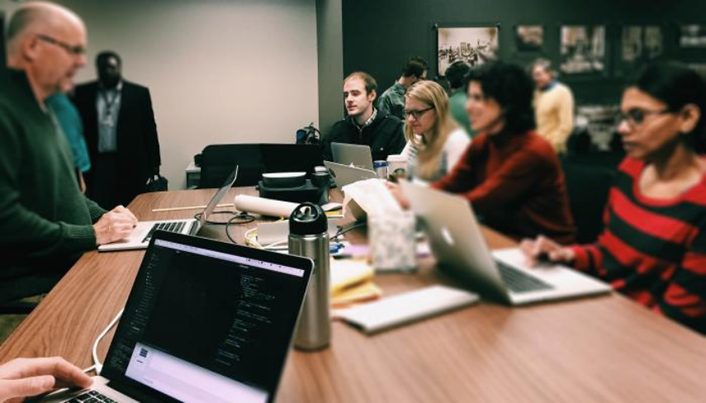
Few can deny that big changes are afoot in higher education. The (still rather new) 21st century has already demonstrated the myriad ways in which education is capable of changing, thanks to novel technologies, ever-more-sophisticated infrastructure, and a willingness to reinvent curricula, course delivery methods and pedagogical training. (Note: this is not intended to be an exhaustive list.)
Where such innovations come from is another story. While edtech companies and educational start-ups aiming to 'disrupt' higher ed from the outside have gained momentum in recent years, some universities have embraced the unknown by creating their own R&D labs for innovation.
Teaching, learning and research aren't mutually exclusive at the University of Michigan.
The university's Office of Digital Education and Innovation is leading a number of projects, with one such 'experiment' among them: a Digital Innovation Greenhouse (DIG), an internal initiative that looks and feels much more like a bustling start-up, where researchers work alongside developers to set the stage for scalable innovations designed specifically for the University of Michigan.
Dr. Timothy McKay is at the epicenter. In addition to serving as an Arthur F. Thurnau Professor of Physics, Astronomy, and Education and Director of the Honors Program for the College of Literature, Science, and the Arts, he is also the Principal Investigator of the internally funded grant that provided the initial funding to establish DIG in 2015.
McKay saw big potential for bringing the start-up approach in-house.
“We knew that faculty innovators on our campus regularly develop education technology innovations, test them in their classes, and show that they can be effective,” McKay said. “What they often can't do is grow these good ideas to scale. Doing so requires a professional team of software developers, user experience designers, and community of practice leads who can discover what potential users really need, design effective human computer interfaces, and mature each project's software infrastructure.”
He explains that the experiment is working well. Since its launch a year ago, DIG has more than doubled its original portfolio of three projects, creating applications now reaching tens of thousands of students.
One such innovation, a holistic, software-based student-support system called ECoach, advises students through their introductory STEM courses. The tool was developed with support from an EDUCAUSE Next Generation Learning Challenges grant.
At its core, DIG is largely aimed at creating a more personalized educational experience for students.
“DIG has always is the formation of tight connections between faculty innovators, a strong technical team dedicated to innovation, and the broadest possible community of users,” McKay said.
The team's success has centered upon continuous communication and an iterative approach, working with six important principles [http://ai.umich.edu/software-dev-guiding-principles/]:
- valuing innovation and creativity,
- understanding users and their needs,
- beginning with a minimum viable product,
- taking an iterative approach,
- using a distributed development workflow,
- and automating processes wherever possible.
“Perhaps the key point is that growing innovations to scale doesn't just happen,” McKay explains. “It requires attention to creating the right environment: building a greenhouse which can grow promising seedlings into mighty oaks.”
Scaling new tools: how are stakeholders' needs taken into account?
On a campus with 42,000 students, this often involves questions of an unusual size — as in, how do we adapt a specific tool that worked for several thousand undergraduate students to all undergraduate and graduate students? In the winter semester alone, more than 4,000 undergrads accessed DIG's Academic Reporting Toolkit 2.0 (Course Profile) tool as part of their course planning and selection process.
Similar to their start-up counterparts, DIG takes project iteration seriously. Mike Daniel serves as Director of Policy and Operation in the Office of Digital Innovation & Education — the office that supports DIG from an operational perspective. He explained that the team receives continuous user feedback from key stakeholder groups on campus. “Development of digital engagement tools within DIG is informed by continuous user feedback, aimed at determining a path forward for each tool that will maximize positive impact on the student experience at U-M.
For the tools that DIG creates, accessibility and functionality are paramount.
“Early on, we in DIG established a set of Software Development Guiding Principles [http://ai.umich.edu/software-dev-guiding-principles/] that our team adheres to in every digital tool we support,” Daniel said. “Through our close connection to both user communities across campus and our Student Fellows Program, we're able to ensure that we are designing and building tools that will actually be responsive to our campus community's needs — as well as being accessible to as large a pool of users as possible.”
Members of the DIG team have presented on the Greenhouse's innovation tools — and the model to support their growth to institutional scale — at various EDUCAUSE events, including the EDUCAUSE Learning Initiative Annual Meeting.
“At the end of the day, the tools that DIG supports are aimed largely at creating a more personalized educational experience for our students,” Daniel said. “Our goal is that these tools — and the data they capture and provide — will lead to more informed decision-making by students, academic leadership, faculty, and staff within the University of Michigan. These tools also provide a platform for research within a variety of academic disciplines, enabling university faculty, students, and staff to study critical research questions related to improving teaching and learning both within our university and beyond.”
Can (and should) other institutions looking for similar innovation-incubating strategies look to DIG?
“We believe the DIG approach is a good model for developing tools which draw on local innovators and grow projects in ways which are responsive to user needs,” McKay said. “It combines the need to efficient grow tools to scale with strong connections to the local user community. So yes, we think it's an effective model of innovation which should serve other institutions well.”
Kristi DePaul of Founders Marketing provides editorial support and regular contributions to the Transforming Higher Ed column of EDUCAUSE Review on issues of teaching, learning, and edtech.
